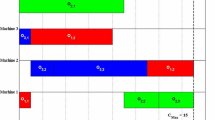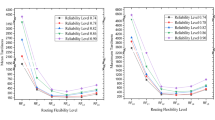Abstract
This paper is concerned with stochastic scheduling of production and maintenance activities in a permutation flow shop setting. We present a two-stage stochastic mixed-integer program (SMIP) that adapts the conventional permutation flow shop scheduling problem for incorporating multiple preventive maintenance activities with various meter-based intervals. The model handles uncertainties in both processing times and the duration of maintenance activities. The concept of combining maintenance activities in scheduling problems is introduced and formulated, along with other practical considerations. The objective is to minimize the total expected cost associated with lateness penalties and maintenance resources. We use simulation–optimization (SO) for solving large-scale instances of the problem, and for validating the SMIP model. Through extensive computational experiments, we show that the SO method is superior in terms of efficiency and effectiveness and evaluate its sensitivity to the input data. Finally, a case study in earth-moving operations is presented, followed by managerial implications.







Similar content being viewed by others
References
Aggoune R (2004) Minimizing the makespan for the flow shop scheduling problem with availability constraints. Eur J Oper Res 153(3):534–543. https://doi.org/10.1016/S0377-2217(03)00261-3
Aghezzaf EH, Jamali MA, Ait-Kadi D (2007) An integrated production and preventive maintenance planning model. Eur J Oper Res 181(2):679–685. https://doi.org/10.1016/j.ejor.2006.06.032
Allaoui H, Artiba A (2004) Integrating simulation and optimization to schedule a hybrid flow shop with maintenance constraints. Comput Ind Eng 47(4):431–450. https://doi.org/10.1016/j.cie.2004.09.002
Ángel-Bello F, Álvarez A, Pacheco J, Martínez I (2011) A single machine scheduling problem with availability constraints and sequence-dependent setup costs. Appl Math Model 35(4):2041–2050. https://doi.org/10.1016/j.apm.2010.11.017
Azadeh A, Asadzadeh SM, Seif J (2014) An integrated simulation-analysis of variance methodology for effective analysis of CBM alternatives. Int J Comput Integr Manuf 27(7):624–637
Baesler FF, Sepúlveda JA (2001) Multi-objective simulation optimization for a cancer treatment center. Paper presented at the simulation conference, 2001. Proceedings of the Winter
Barton RR, Meckesheimer M (2006) Metamodel-based simulation optimization. Handb Oper Res Manag Sci 13:535–574
Ben-Daya M, Ait-Kadi D, Duffuaa SO, Knezevic J, Raouf A (2009) Handbook of maintenance management and engineering, vol 7. Springer, Berlin
Berry PM (1993) Uncertainty in scheduling: probability, problem reduction, abstractions and the user. Paper presented at the IEE Colloquium on advanced software technologies for scheduling
Bertolini M, Mezzogori D, Zammori F (2019) Comparison of new metaheuristics, for the solution of an integrated jobs-maintenance scheduling problem. Expert Syst Appl 122:118–136
Blum C, Roli A (2003) Metaheuristics in combinatorial optimization: overview and conceptual comparison. ACM Comput Surv (CSUR) 35(3):268–308
Bock S, Briskorn D, Horbach A (2012) Scheduling flexible maintenance activities subject to job-dependent machine deterioration. J Sched 15:1–14
Carson Y, Maria A (1997) Simulation optimization: methods and applications. Paper presented at the Proceedings of the 29th conference on Winter simulation
Caterpillar (2010a) 725 and 730 OEM Articulated trucks—maintenance intervals. In: Operation and maintenance manual excerpt. Retrieved March 30, 2015, from https://safety.cat.com
Caterpillar (2010b) 988 Wheel loader—maintenance intervals. In: Operation and maintenance manual excerpt. Retrieved March 30, 2015, from https://safety.cat.com
Caterpillar (2010c) M312 and M315 Excavators—maintenance intervals. In: Operation and maintenance manual excerpt. Retrieved March 30, 2015, from https://safety.cat.com
Cheng TE, Wang G (1999) Two-machine flowshop scheduling with consecutive availability constraints. Inf Process Lett 71(2):49–54
Cheng TCE, Wang G (2000) An improved heuristic for two-machine flowshop scheduling with an availability constraint. Oper Res Lett 26(5):223–229. https://doi.org/10.1016/S0167-6377(00)00033-X
Chica M, Juan Pérez AA, Cordon O, Kelton D (2017) Why simheuristics? Benefits, limitations, and best practices when combining metaheuristics with simulation. Available at SSRN: https://ssrn.com/abstract=2919208 or https://doi.org/10.2139/ssrn.2919208
Choi B-C, Lee K, Leung JYT, Pinedo ML (2010) Flow shops with machine maintenance: ordered and proportionate cases. Eur J Oper Res 207(1):97–104. https://doi.org/10.1016/j.ejor.2010.04.018
Dehghanimohammadabadi M (2016) Iterative optimization-based simulation (IOS) with predictable and unpredictable trigger events in simulated time. Western New England University, Springfield
Dehghanimohammadabadi M, Keyser TK (2017) Intelligent simulation: integration of SIMIO and MATLAB to deploy decision support systems to simulation environment. Simul Model Pract Theory 71:45–60
Dehghanimohammadabadi M, Keyser TK, Cheraghi SH (2017) A novel iterative optimization-based simulation (IOS) framework: an effective tool to optimize system’s performance. Comput Ind Eng 111(Supplement C):1–17. https://doi.org/10.1016/j.cie.2017.06.037
Dekker R (1995) Integrating optimisation, priority setting, planning and combining of maintenance activities. Eur J Oper Res 82(2):225–240
Dekkert R, Smit A, Losekoot J (1991) Combining maintenance activities in an operational planning phase: a set-partitioning approach. IMA J Manag Math 3(4):315–331
Fu J (2013) Logistics of earthmoving operations: simulation and optimization. KTH Royal Institute of Technology, Stockholm
Göçken M, Boru A, Dosdoğru AT, Geyik F (2015) (R, s, S) inventory control policy and supplier selection in a two-echelon supply chain: an optimization via simulation approach. Paper presented at the Proceedings of the 2015 Winter simulation conference
González-Neira E, Montoya-Torres J, Barrera D (2017) Flow-shop scheduling problem under uncertainties: review and trends. Int J Ind Eng Comput 8(4):399–426
Gourgand M, Grangeon N, Norre S (2000) A review of the static stochastic flow-shop scheduling problem. J Decis Syst 9(2):1–31
Güden H, Süral H (2014) Locating mobile facilities in railway construction management. Omega 45:71–79. https://doi.org/10.1016/j.omega.2014.01.001
Hastings NAJ (2009) Physical asset management. Springer, Berlin
Holland J (1975) Adaption in natural and artificial systems. The University of Michigan Press, Ann Arbor
Hong LJ, Nelson BL, Xu J (2015) Discrete optimization via simulation. In: Fu M (ed) Handbook of simulation optimization. Springer, Berlin, pp 9–44
Jalali H, Nieuwenhuyse IV (2015) Simulation optimization in inventory replenishment: a classification. IIE Trans 47(11):1217–1235
Johnson SM (1954) Optimal two-and three-stage production schedules with setup times included. Naval Res Logist (NRL) 1(1):61–68
Juan AA, Faulin J, Grasman SE, Rabe M, Figueira G (2015) A review of simheuristics: extending metaheuristics to deal with stochastic combinatorial optimization problems. Oper Res Perspect 2:62–72
Kerkhove LP, Vanhoucke M (2017) Optimised scheduling for weather sensitive offshore construction projects. Omega 66:58–78. https://doi.org/10.1016/j.omega.2016.01.011
Knezevic J (1997) Systems maintainability, vol 1. Springer, Berlin
Kroep S (2017) Clustering of aircraft maintenance jobs at AIS airlines. University of Twente, Enschede
Kubiak W, Błażewicz J, Formanowicz P, Breit J, Schmidt G (2002) Two-machine flow shops with limited machine availability. Eur J Oper Res 136(3):528–540. https://doi.org/10.1016/S0377-2217(01)00083-2
Kubzin MA, Potts CN, Strusevich VA (2009) Approximation results for flow shop scheduling problems with machine availability constraints. Comput Oper Res 36(2):379–390. https://doi.org/10.1016/j.cor.2007.10.013
Lee C-Y (1997) Minimizing the makespan in the two-machine flowshop scheduling problem with an availability constraint. Oper Res Lett 20(3):129–139. https://doi.org/10.1016/S0167-6377(96)00041-7
Lee C-Y (1999) Two-machine flowshop scheduling with availability constraints. Eur J Oper Res 114(2):420–429. https://doi.org/10.1016/S0377-2217(97)00452-9
Lee CY, Leon VJ (2001) Machine scheduling with a rate-modifying activity1. Eur J Oper Res 128(1):119–128. https://doi.org/10.1016/S0377-2217(99)00066-1
Lin JT, Chiu C-C, Chang Y-H (2017) Simulation-based optimization approach for simultaneous scheduling of vehicles and machines with processing time uncertainty in FMS. Flex Serv Manuf J 1:1. https://doi.org/10.1007/s10696-017-9302-x
Ortiz NR, Diaz FJ (2018) The project scheduling problem with non-deterministic activities duration: a literature review. J Ind Eng Manag 11(1):116
Pinedo M (2012) Scheduling. Springer, Berlin
Rani D, Moreira MM (2010) Simulation–optimization modeling: a survey and potential application in reservoir systems operation. Water Resour Manag 24(6):1107–1138
Rossit DA, Tohmé F, Frutos M (2018) The non-permutation flow-shop scheduling problem: a literature review. Omega 77:143–153. https://doi.org/10.1016/j.omega.2017.05.010
Seif J, Yu AJ, Rahmanniyay F (2018) Modeling and optimization of a bi-objective flow shop scheduling with diverse maintenance requirements. Int J Prod Res 56(9):3204–3225
Trevino V, Falciani F (2006) GALGO: an R package for multivariate variable selection using genetic algorithms. Bioinformatics 22(9):1154–1156. https://doi.org/10.1093/bioinformatics/btl074
Truong TH, Azadivar F (2003) Simulation optimization in manufacturing analysis: simulation based optimization for supply chain configuration design
Xu D, Wan L, Liu A, Yang DL (2015) Single machine total completion time scheduling problem with workload-dependent maintenance duration. Omega (United Kingdom) 52:101–106. https://doi.org/10.1016/j.omega.2014.11.002
Yenisey MM, Yagmahan B (2014) Multi-objective permutation flow shop scheduling problem: literature review, classification and current trends. Omega 45:119–135. https://doi.org/10.1016/j.omega.2013.07.004
Yip H-L, Fan H, Chiang Y-H (2014) Predicting the maintenance cost of construction equipment: comparison between general regression neural network and Box–Jenkins time series models. Autom Constr 38:30–38. https://doi.org/10.1016/j.autcon.2013.10.024
Yoo J, Lee IS (2016) Parallel machine scheduling with maintenance activities. Comput Ind Eng 101(Supplement C):361–371. https://doi.org/10.1016/j.cie.2016.09.020
Yu AJ, Seif J (2016) Minimizing tardiness and maintenance costs in flow shop scheduling by a lower-bound-based GA. Comput Ind Eng 97:26–40
Zheng Y, Lian L, Fu Z, Mesghouni K (2015) Evolutional algorithm in solving flexible job shop scheduling problem with uncertainties. In: LISS 2013. Springer, pp. 1009–1015
Author information
Authors and Affiliations
Corresponding author
Additional information
Publisher's Note
Springer Nature remains neutral with regard to jurisdictional claims in published maps and institutional affiliations.
Appendix: Generating the coefficients
Appendix: Generating the coefficients
Consider the set \(\varvec{a} = \left\{ {a_{1} ,a_{2} , \ldots ,a_{l} } \right\}, \forall k = 1, \ldots ,l, a_{k} \in {\mathbb{R}}\). \(\varvec{S} = \left\{ {\varvec{s}_{1} ,\varvec{s}_{2} , \ldots ,\varvec{s}_{{2^{\varvec{l}} }} } \right\}\) is the set of all the possible subsets of \(\varvec{a}\) that are not null, and \(\varvec{b} = \left\{ {b_{1} ,b_{2} , \ldots ,b_{{2^{l} }} } \right\} { \ni } b_{r} = \mathop \sum \nolimits_{{a^{\prime} \in \varvec{s}_{\varvec{r}} }} a^{\prime},\forall r = 1, \ldots ,2^{l}\). We want to find the elements of \(\varvec{a}\) such that the elements of \(\varvec{b}\) are unique. For example, for \(\varvec{ a}_{1} = \{ 1,2,3\} ,\;l = 3\), \(\varvec{S}_{1} = \{ \{ 1\} ,\{ 2\} ,\{ 3\} ,\{ 1,2\} ,\{ 1,3\} ,\{ 2,3\} ,\{ 1,2,3\} \} \therefore \;\varvec{b}_{1} = \{ 1,2,3,3,4,5,6\}\), where the members of \(\varvec{b}_{1}\) are not unique. But for \(\varvec{a}_{2} = \{ 1.1,1.2,1.3\} ,l = 3\), \(\varvec{S}_{2} = \{ \{ 1.1\} ,\{ 1.2\} ,\{ 1.3\} ,\{ 1.1,1.2\} ,\{ 1.1,1.3\} ,\{ 1.2,1.3\} ,\{ 1.1,1.2,1.3\} \} \therefore \;\varvec{b}_{2} = \{ 1.1,1.2,1.3,2.3,2.4,2.5,3.6\}\), where the members of \(\varvec{b}_{2}\) are unique. The following proposition shows one way of generating \(\varvec{a}\).
Proposition 1
If \(\varvec{a} = \left\{ {1.1,1.01, \ldots ,1.0\underbrace {0 \ldots 0}_{l - 1}1} \right\},\left| \varvec{a} \right| = l,\) the uniqueness of the elements in \(\varvec{b}\) is guaranteed.
Proof
For \(\varvec{a} = \left\{ {1.1,1.01, \ldots ,1.\underbrace {00 \ldots 0}_{l - 1}1} \right\},\left| \varvec{a} \right| = l\):
Assume \(\exists b_{i} ,b_{j} \in \varvec{b}\,and\,\varvec{s}_{\varvec{i}} ,\varvec{s}_{\varvec{j}} \in \varvec{S}{ \ni }b_{i} = b_{j}\,and\,\varvec{s}_{\varvec{i}} \ne \varvec{s}_{\varvec{j}}\). Because \(b_{i} = b_{j}\), the integer and decimal parts of the two numbers are equal. Because the integer parts of all of the elements in \(\varvec{a}\) are the same (1), the integer part of \(b_{i}\) and \(b_{j}\) indicate the number of elements in their respective subsets, i.e. \(\varvec{s}_{\varvec{i}}\) and \(\varvec{s}_{\varvec{j}}\). Because all elements in each subset have 1 as their integer part and each element has a unique number of zeros in the decimal part, the elements have to be equal for \(b_{i}\) and \(b_{j}\) to be equal. If the elements of \(\varvec{s}_{\varvec{i}}\) and \(\varvec{s}_{\varvec{j}}\) are identical, \(\varvec{s}_{\varvec{i}} = \varvec{s}_{\varvec{j}}\). which contradicts the assumption. Therefore, for \(\varvec{a} = \left\{ {1.1,1.01, \ldots ,1.\underbrace {00 \ldots 0}_{l - 1}1} \right\},\left| \varvec{a} \right| = l\) the elements of \(\varvec{b}\) are unique.□
Rights and permissions
About this article
Cite this article
Seif, J., Dehghanimohammadabadi, M. & Yu, A.J. Integrated preventive maintenance and flow shop scheduling under uncertainty. Flex Serv Manuf J 32, 852–887 (2020). https://doi.org/10.1007/s10696-019-09357-4
Published:
Issue Date:
DOI: https://doi.org/10.1007/s10696-019-09357-4




